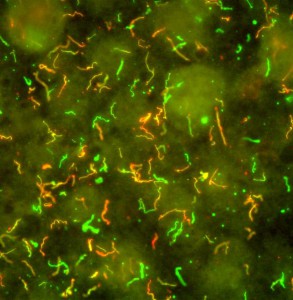

With the increase in global biodiversity loss comes the search for an understanding of how biodiversity loss will affect people or how conserving biodiversity in may benefit people. These benefits are termed “ecosystem services” and encompass the wide range of resources and processes that regulate the environment, provide food, materials and cultural stimulation and contribute to other ecosystem services. One such suggested ecosystem service is that diverse ecosystems may reduce the risk of zoonosis (pathogen transmitted from animals to humans).
The underlying concept is that vertebrate hosts differ in their relative competence as transmission hosts of vector-borne pathogens, consequently, the distribution of vectors among host species will affect the transmission potential of pathogens. For example, if a large proportion of the vector population feeds solely on non-competent transmission hosts then the pathogen is unlikely to persist within that system (R0<1). The underlying rationale is that a smaller proportion of vectors will feed on competent hosts and so will not acquire an infection and that some of those vectors that do acquire an infection will subsequently feed on non-competent hosts and potentially infective bites are lost from the system. This concept has been termed the “dilution effect”. The most compelling evidence for this theory has came from Dr. Richard Ostfeld and colleagues, who over the last 15 years have published numerous papers examining the effects of how the diversity of small mammals in woodlands in the US may reduce zoonotic disease risk due to the tick-borne pathogen, Borrelia burgdorferi, the causative agent of Lyme borreliosis.
In this system, the black-legged tick Ixodes scapularis is the vector of B. burgdorferi and has a wide host range, parasitising mammals, birds and reptiles. Some hosts such as white-footed mice, Peromyscus leucopus, and Eastern chipmunks, Tamias striatus, are competent transmission hosts of B. burgdorferi while others such as ground dwelling birds, lizards or raccoons are considered poor or incompetent reservoirs. Through empirical data and theoretical models Ostfeld et al., have argued that diverse communites may reduce the prevalence of infection of B. burgdorferi in ticks (and consequently the risk to the public health) as a greater proportion of ticks would feed on non-competent hosts than if the host community was dominated by a competent species. They have also suggested that the conditions required for the dilution effect to occur may be present in a number of other disease systems and as such the dilution effect (and the biodiversity mitigates disease concept) may be a more general phenomenon.
Understandably, the attractive concept that biodiversity may reduce the risk of disease in humans has proved popular and prompted research in other vector-borne systems (e.g. WNV, mosquitoes and birds) as well as for systems involving indirectly ( e.g. Schistosoma and snails) and directly transmitted parasites (e.g. Hantavirus and rodents). However, not everyone is convinced that the dilution effect is a general concept; in the June 2012 issue of Parasitology Randolph and Dobson provide a comprehensive review of the dilution effect literature along with an equally enthusiastic critique of the dilution effect. They argue that the “biodiversity buffers disease” concept is Panglossian (after Dr. Pangloss, an overly optimistic character in Voltaire’s 1759 satire, Candide) and utilitarian, applicable only in certain extreme and simplified systems and is therefore not a general phenomenon and further should not be used to guide funding or policy. Ostfeld’s rebuttal in September of this year highlights distortions and errors in the critique asserting that dilution effect theory has been developed carefully considering the complexities of community ecology and that the dilution effect is widespread among plant and animal disease systems. In somewhat of a middle ground a meta-analysis published in Ecology Letters in May this year suggests the overall relationship between biodiversity and disease is weak and effects are idiosyncratic to specific disease systems.
Clearly, there is a wide spectrum of views on the effects of biodiversity on disease risk, further studies will elucidate the role of biodiversity in mitigating risk and will further reveal the extent to which the dilution effect is present in disease systems. Given the complexities of pathogen and vector life histories, host-vector interactions and host community structure a pragmatic approach would be to examine each system in its own right rather than have generalised concepts about the role of biodiversity in mitigating disease risk. One thing for certain is that the discussion surrounding biodiversity and disease risk will continue.

Comments